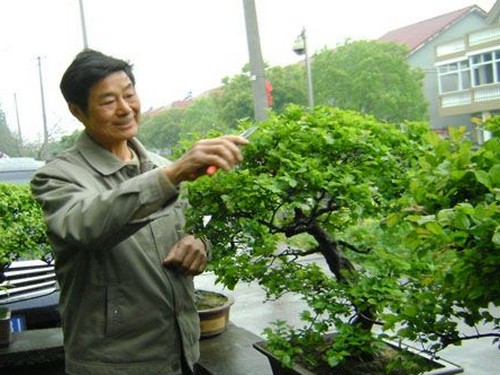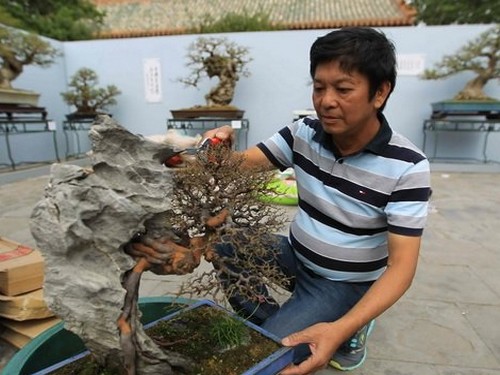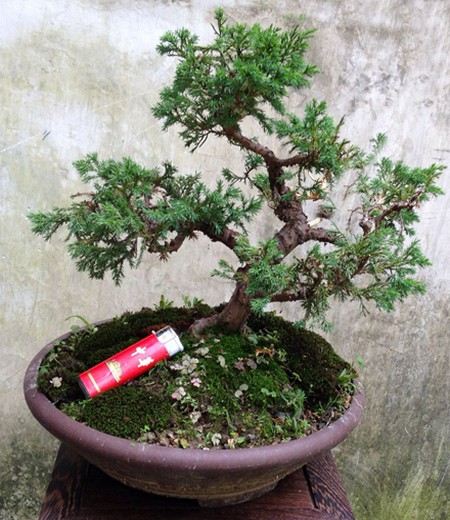Bonsai creation: strange layout, the small sees the big
After the abdominal manuscript is typed, it can be arranged according to the rules. Layout is the layout and settlement of the scenery, that is, modeling. No matter what the theme is, bonsai emphasizes the artistic effect of seeing the big in the small more than the garden. The better the effect, the higher the artistic value of bonsai.

Although there are large bonsai in bonsai, they are still small compared to towering ancient trees and thousands of miles of rivers and mountains, not to mention the general bonsai are small and medium-sized bonsai. In order to show the scene of thousands of cliffs in a basin of 20 to 30 centimeters or more, one must be skillful in layout in order to receive the artistic effect of meeting people in a small school. Bai Juyi wrote in the poem "the appearance of cattle returned to Renli and Xincheng Xiaotan," Bai Juyi wrote: "in this case, inside the Zhu door." A thousand punches in Luoshi... Two rocks are close to the mouth, and one is Xiaoxiang Heaven. Baxia sound in the heart, in front of the Songjiang color. "
In the Song Dynasty, Su Dongpo made bonsai with two stones in Yangzhou. "but when he saw that the jade peak was too white, he started from the bird path." the bonsai he created could achieve the artistic conception of "Sanfeng", "Jiuhua", "Wuling" and "Qianzhang" between "one palm" and "one pot". This is a typical example of the most ingenious application of small, medium and large techniques. The poet Lu you's bonsai also uses the artistic technique of "digging the pond to hold the water of Dendrobium and building the stone effect Yaozen". So, how can we achieve the effect of expanding art space by seeing the big in the small?
One is to increase the level by using the principle of scatter perspective. The so-called scatter perspective is to see through the scenery at many different points, like looking at Emei at the bottom of the mountain, you can only see a mountain, you can't see it heavily, let alone the hills and valleys. For example, in order to express the artistic conception of "only the Yangtze River rushes to the horizon", the mountains on this bank must be low-row, and the mountains on the other side must be steep, so that the viewer can feel that the water is vast and far-reaching and there is no end in sight. although this paspalum shape is different from the perspective principle of the near big and far small, but the effect is the same?
Therefore, in the layout, it is necessary to see through the scattered points, that is, the levels of thousands of stacked clouds seen "in the big view and the small", using the technique of "shrinking the dragon into inches", that is, dividing the limited space close at hand into several levels. the effect of expanding the depth of field and rich layers can be achieved when watching bonsai, because of the appeal of the head-up view, people feel that the water is thousands of miles away; because of the appeal of looking up at the scenery, it makes people feel higher than a thousand miles away. The creator observes the true mountain and the real water, and uses the scatter perspective principle when creating bonsai. Because viewers always watch the bonsai at a certain point, they must also consider the viewing effect of a little perspective when creating.
Therefore, the creation of bonsai should not only follow the above principles, but also be dealt with at different levels of vertical height and horizontal direction. The texture of mountains and rocks should be delicate in the near and summarized in the distance; the lower officials should be clear and the upper should be vague; the near trees should be large and the distant trees should be small, and even the distant mountain forest should be expressed with moss. Even the moss is not needed for the farthest and highest view. Long-range close-up, the line outline of the close-up ratio should not be the same. Bonsai is often made of three layers, such as the outer layer is horizontal, the middle layer must be more vertical, and the inner layer should be horizontal. This is the "far, middle and near triple method" of bonsai layout. A hundred people have the taboo of "small feet" and "do not plant trees in high mountains". As Wang Wei said in the Theory of Landscape decision, "distant people have no eyes, distant trees have no branches, distant mountains have no stones, and they are as faint as eyebrows. It is also a vivid portrayal of the appeal of the plain scenery.
The second is to pay attention to proportion, contrast and contrast. In order for bonsai to have the effect of seeing the big from the small, it is very important to pay attention to the appropriate proportion of objects and colors in the basin and apply contrast techniques. " If you grow a foot tree, you will divide a man by an inch. "what we are talking about is the approximate proportional relationship between large and small scales." the singing mountains of birds are quieter, and the voice of cicadas is quieter and quieter, which is a foil to making noise and seeking stillness. All things are distinguished in comparison. High and low size, straightness, light and shade, shade, density, movement and so on, all exist because of the ratio hinge. Everything on earth, together with the earth, moves at the same speed, and it is impossible to distinguish without still life as a reference. Reference objects are often used for comparison in Chinese painting, and the use of this is an important means for bonsai to achieve great artistic effect in small and medium-sized plants. The methods are as follows:
1. Set off the steep pull of the high mountains with low mountains
2. Set off the magnificent use of high mountains with tiny old trees
3. Small bridge pavilions, towers, boats, figures and other embellishments are used as the scale to set off the vastness of the water area and the majestic mountains.
4. set off the majestic grandeur of the scenery with a shallow basin.
5. Far away with sparse lining. For example, the hundred-li map of the Lijiang River, created by the Guilin artist Qin Xiong, is ingenious, using large and small, near delicate, far generalization, scattered spots, using asparagus instead of the green bamboo along the Lijiang River, and using a 12-meter-long shallow basin to set off the clear water surface of the Lijiang River and the towering undulating mountains, bringing together the main scenery of the Lijiang River in the basin, so she has made good achievements in the artistic effect. In the application of embellishments (also known as furnishings), it should not be too large and too complex, otherwise it will lose the function of scale and become vulgar. The layout of heavy mountains and mountains, moving the sky and shrinking the earth into a small basin, if hidden cleverly, can make the viewer feel that they do not know how many there are in front of the mountain, behind the mountain, on the left and right of the mountain, and thus have associations. The layout of bonsai should be hidden and exposed, obvious and clear, not only the near and far levels are clear, but also interesting; if you can hide more than reveal, the more interesting it will be. Tibetan scenery requires not only hiding and dew on the plane, but also a layer above one layer in three-dimensional space, and there is also a layer in one layer. Now some rockery use water spray to replace smoke clouds, and there is a long sound of piano, in addition, compared to stone bamboo trees, sailboats, bridges, pavilions, each other into a hidden scene, then its artistic conception is far-reaching.
Third, the application of specific scenery to arouse people's association. This is to expand the artistic conception to achieve the effect of seeing the big in the small. For example, there is a "listening to Yuxuan" in the Humble Administrator's Garden in Suzhou, lighting the scene with banana leaves and matching with strange stones, making people feel trapped. In addition, in the bonsai, waterfalls are also used to express the mountains and basin scenes outside the mountains, and the water surface is used to express the artistic conception such as the vast river sky.
In short, although the bonsai is small, as long as the technique is ingenious and the layout is proper, it can achieve the artistic effect of the peak of three inches, the height of a thousand feet, the length of the basin close at hand and the return of a hundred miles of body.
Time: 2019-05-23 Click:
- Prev

Bonsai creation: the first intention, throughout
The so-called intention is that before the creation, after the author gets the tree embryo, or the processing method of the rock, according to its morphological characteristics and the characteristics of the material itself, combined with its own artistic accomplishment, make a general conception of the work. This thinking process includes the use of the appearance, size and branches of the work and the design of the matching pot.
- Next

The naming of bonsai
The name of bonsai is also an excuse that we often take pride in, and at the same time, it is often used to belittle others, thinking that there is no name on the lack of artistic conception, etc. If so, Lao Tzu said: Tao can be Tao, very Tao; Name can be named, very name. So what's wrong with having no name? No name, no name.
Related
- Fuxing push coffee new agricultural production and marketing class: lack of small-scale processing plants
- Jujube rice field leisure farm deep ploughing Yilan for five years to create a space for organic food and play
- Nongyu Farm-A trial of organic papaya for brave women with advanced technology
- Four points for attention in the prevention and control of diseases and insect pests of edible fungi
- How to add nutrient solution to Edible Fungi
- Is there any good way to control edible fungus mites?
- Open Inoculation Technology of Edible Fungi
- Is there any clever way to use fertilizer for edible fungus in winter?
- What agents are used to kill the pathogens of edible fungi in the mushroom shed?
- Rapid drying of Edible Fungi

